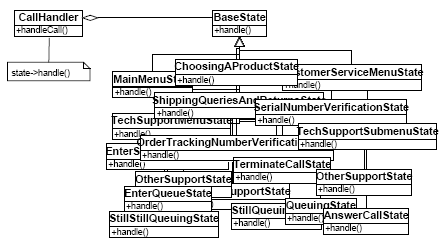This article is more than 1 year old
In the beginning, there was the flowchart...
Software diagramming - a warning from history
State of the art
From the foregoing, you may have formed the impression that I am against all diagrams. Not so. The moment is overdue for a mention for the queen of all software diagrams: the state transition.
Out of all the techniques I have described, only the state transition diagram really delivers. It alone can show compressed ideas that would otherwise be hard to express, and it is one of the few diagrams one can draw to design the program, rather than put together retrospectively to document a design one has conceived in another form.
Enough abstract discussion. As a concrete example, here is a state transition diagram I drew a few years ago, portraying the automatic call handling system of a customer care centre:

I feel sure you agree that this diagram is a paragon of terse clarity.
In fact, equipped with the above, one has all the information needed to design the system's classes. An excellent opportunity to segue into another kind of diagram: the UML class diagram. To keep up the standards of good practice you expect from me, I will (of course) use the Gang of Four's famous State pattern to create my design. Here we go:

Those of you who are watching carefully will notice a slight drop in clarity of intention and available information between the state transition diagram and the class diagram derived from it.
To be fair - and with considerable reluctance - I admit that this is not really the fault of the UMLerites. It is an unhappy consequence of the way the State pattern works that the underlying design is buried in a blizzard of silly little classes. This difficulty is reflected in the production code.
Public Service Announcement: fellow programmers who experience this genuine problem in real life, and who code in C, C++, C#, Java or one of seven other languages, should urgently haul their sorry browsers down to smc.sourceforge.net and pull down a copy of Charles Rapp's splendid State Machine Compiler. This elegant utility, easily bodged into the build, allows you to work directly from your state transition design, without bothering your pretty head with the implementation of the State pattern. Once you have tried it, I promise you will never hand-code State again.
Now let us continue, while we bring the flowchart into the modern era...
